Royal Norwegian Air Force
| Royal Norwegian Air Force Luftforsvaret | |
|---|---|
|
Royal Norwegian Air Force emblem | |
| Founded | November 10, 1944 |
| Country | Norway |
| Size | 3,650 (doesn't include Air Home Guard) |
| Part of | Norwegian Armed Forces |
| Motto(s) | For King, People and Fatherland |
| Commanders | |
| Commander in Chief | HM King Harald V |
| Inspector General of the Air Force |
Major General Per Egil Rygg (11 April 2014 – present)[1] |
| Insignia | |
| Roundel |
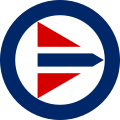 |
| Low Visibility Roundel |
 |
| Aircraft flown | |
| Attack | Lockheed F-16 Fighting Falcon |
| Bomber | Lockheed F-16 Fighting Falcon |
| Electronic warfare | Dassault Falcon 20 |
| Fighter | Lockheed F-16 Fighting Falcon |
| Helicopter | Westland Sea King, Bell 412, NH-90 |
| Patrol | Lockheed P-3 Orion |
| Trainer | SAAB Safari |
| Transport | C-130 Hercules |
The Royal Norwegian Air Force (RNoAF) (Norwegian: Luftforsvaret) is the air force of Norway. It was established as a separate arm of the Norwegian armed forces on 10 November 1944. The RNoAF's peacetime establishment is approximately 1,430 employees (officers, enlisted staff and civilians). 600 personnel also serve their draft period in the RNoAF. After mobilization the RNoAF would consist of approximately 5,500 personnel.
The infrastructure of the RNoAF includes seven airbases (at Andøya, Bardufoss, Bodø, Gardermoen, Rygge, Sola and Ørland), two control and reporting centres (at Sørreisa and Mågerø) and three training centres (at Kjevik in Kristiansand and Persaunet in Trondheim) and at KNM HH/Madlaleiren (Stavanger).
History
Conception
Military flights started on 1 June 1912. The first plane, HNoMS Start, was bought with money donated by the public and piloted by Hans Dons, second in command of the submarine HNoMS Kobben (A-1).[2] Up until 1940 most of the aircraft belonging to the Navy and Army air forces were domestic designs or built under license agreements, the main bomber/scout aircraft of the Army air force being the Dutch-origined Fokker C.V.
| |
| Components |
|---|
| Navy (Coast Guard) Air Force Home Guard Cyber Defence Force |
| Ranks |
| Norwegian military ranks |
| Bugle calls |
| Bugle calls of the Norwegian Army |
| Armed Forces equipment |
| Army equipment Norwegian naval ships Norwegian military aircraft |
World War II
Build-up for World War II

Before 1944 the Air Force were divided into the Norwegian Army Air Service (Hærens Flyvevaaben) and the Royal Norwegian Navy Air Service (Marinens Flyvevaaben).
In the late 1930s, as war seemed imminent, more modern aircraft was bought from abroad, including twelve Gloster Gladiator fighters from the UK, and six Heinkel He 115s from Germany. Considerable orders for aircraft were placed with United States companies during the months prior to the invasion of Norway on 9 April 1940.
The most important of the US orders were two orders for comparatively modern Curtiss P-36 Hawk monoplane fighters. The first was for 24 Hawk 75A-6 (with 1200 hp Pratt & Whitney R-1830-SC3-G Twin Wasp engines), 19 of which were delivered before the invasion. Of these 19, though, none were operational when the attack came. A number were still in their shipping crates in Oslo harbour, while others stood at the Kjeller aircraft factory, flight ready, but none combat ready. Some of the Kjeller aircraft had not been fitted with machine guns, and those that had been fitted still lacked gun sights.
The ship with the last five 75A-6s that were bound for Norway was diverted to the United Kingdom, where they were taken over by Royal Air Force (RAF). All 19 Norwegian P-36s that were captured by the German invaders were later sold by the German authorities to the Finnish Air Force, which was to use them to good effect during the Continuation War.
The other order for P-36s was for 36 Hawk 75A-8 (with 1200 hp Wright R-1820-95 Cyclone 9 engines), none of which were delivered in time for the invasion, but were delivered to "Little Norway" near Toronto, Ontario, Canada. There they were used for training Norwegian pilots until the USAAF took over the aircraft and used them under the designation P36G.
Also ordered prior to the invasion were 24 Northrop N-3PB float planes built in on Norwegian specifications for a patrol bomber. The order was made on 12 March 1940 in an effort to replace the Royal Norwegian Navy Air Service's obsolete MF.11 biplane patrol aircraft. None of the type were delivered by 9 April and when they became operational with the 330 (Norwegian) Squadron in May 1941 they were stationed at Reykjavík, Iceland performing anti-submarine and convoy escort duties.

Escape and exile
The unequal situation led to the rapid defeat of the Norwegian air forces, even though seven Gladiators from Jagevingen (the fighter wing) defended Fornebu airport against the attacking German forces with some success – claiming two Me 110 heavy fighters, two He 111 bombers and one Junkers Ju 52 transport. Jagevingen lost two Gladiators to ground strafing while they were rearming on Fornebu and one in the air, shot down by Future Experte Helmut Lent, injuring the sergeant pilot. After the withdrawal of allied forces, the Norwegian Government ceased fighting in Norway and evacuated to the United Kingdom on 10 June 1940.
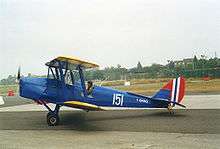
Only aircraft of the Royal Norwegian Navy Air Service had the range to fly all the way from their last remaining bases in Northern Norway to the UK. Included amongst the Norwegian aircraft that reached the British Isles were four German-made Heinkel He 115 seaplane bombers, six of which were bought before the war and two more were captured from the Germans during the Norwegian Campaign. One He 115 also escaped to Finland before the surrender of mainland Norway, as did three M.F. 11s; landing on Lake Salmijärvi in Petsamo. A captured Arado Ar 196 originating from the German heavy cruiser Admiral Hipper was also flown to Britain for testing.
For the Norwegian Army Air Service aircraft the only option for escape was Finland, where the planes would be interned but at least not fall into the hands of the Germans. In all two Fokker C.V.s and one de Havilland Tiger Moth made it across the border and onto Finnish airfields just before the capitulation of mainland Norway. All navy and army aircraft that fled to Finland were pressed into service with the Finnish Air Force,[3] while most of the aircrew eventually ended up in "Little Norway".
The Army and Navy air services established themselves in Britain under the command of the Joint Chiefs of Staff. Norwegian air and ground crews operated as part of the British Royal Air Force, in both wholly Norwegian squadrons and also in other squadrons and units such as RAF Ferry Command and RAF Bomber Command. In particular, Norwegian personnel operated two squadrons of Supermarine Spitfires: RAF 132 (Norwegian) Wing consisted of No. 331 (Norwegian) Squadron and RAF No. 332 (Norwegian) Squadron. Both planes and running costs were financed by the exiled Norwegian government.
In the autumn of 1940, a Norwegian training centre known as "Little Norway" was established next to Toronto Island Airport, Canada.
The Royal Norwegian Air Force (RNoAF) was established by a royal decree on 1 November 1944, thereby merging the Army and Navy air forces. No. 331 (Norwegian) Squadron defended London from 1941 and was the highest scoring fighter squadron in South England during the war.
Up until 8 May 1945, 335 persons had lost their lives while taking part in the efforts of the RNoAF.
Post-war air force

After the war the Spitfire remained in service with the RNoAF into the fifties.
In 1947, the Surveillance and Control Division acquired its first radar system, and around the same time the RNoAF got its first jet fighters in the form of de Havilland Vampires.
In 1949 Norway co-founded NATO, and soon afterwards received American aircraft through the MAP (Military Aid Program). The expansion of the Air Force happened at a very rapid pace as the Cold War progressed. Throughout the Cold War the Norwegian Air Force was only one of two NATO air forces — Turkey being the other — with a responsibility for an area with a land border with the Soviet Union, and Norwegian fighter aircraft had on average 500–600 interceptions of Soviet aircraft each year.[4]
In 1959, the Anti-Aircraft Artillery was integrated into the Royal Norwegian Air Force.
In 1999, Norway participated with a number of F-16s during operation 'Allied Force',[5]
21st century RNoAF
In October 2002, a tri-national force of 18 Norwegian, Danish, and Dutch F-16 fighter-bombers, with one Dutch Air Force KC-10A tanker, flew to the Manas Air Base in Kyrgyzstan, to support the NATO ground forces in Afghanistan as a part of the Operation Enduring Freedom. One of the missions was Operation Desert Lion.[6]
In 2004, four F-16s participated on NATO's Baltic Air Policing operation.
Since February, 2006, eight Royal Netherlands Air Force F-16s, joined by four Royal Norwegian Air Force F-16s, have been supporting NATO International Security Assistance Force ground troops mostly in the southern provinces of Afghanistan. The air detachment is known as the 1st Netherlands-Norwegian European Participating Forces Expeditionary Air Wing (1 NLD/NOR EEAW).[7]
2010s
Libyan no-fly zone : – In a statement, Foreign Minister Jonas Gahr Støre condemned the violence against "peaceful protesters in Libya, Bahrain and Yemen", saying the protests "are an expression of the people’s desire for more participatory democracy. The authorities must respect fundamental human rights such as political, economic and social rights. It is now vital that all parties do their utmost to foster peaceful dialogue on reforms.".[8] On 19 March 2011 the Norwegian government authorized The Royal Norwegian Air Force to head for Libya and prepare for missions there. Norway has approved six General Dynamics F-16 Fighting Falcon fighters and necessary personnel. These fighters will head for Greece on 21 March and operate from the Souda Air Base in Souda Bay on Crete .[9] On 24 March 2011, F-16s from the Royal Norwegian Air Force was assigned to the United States Africa Command and the Operation Odyssey Dawn. A number of Norwegian F-16s took off from their base in Greece for their first mission over Libya.[10][11] On 25 March 2011, 3 laserguided bombs were launched from 2 F-16s of the Royal Norwegian Air Force against Libyan tanks and during the night towards 26 March an airfield was bombed. . Equipment also deployed to Operation Unified Protector on 26 March 2011.[12][13] By July 2011 the Norwegian F-16's had dropped close to 600 bombs, some 17% of the total bombs dropped at that time.[14][15][16] It was Norwegian F-16s that on the night towards 26 April, bombed Gaddafis headquarter in Tripoli[15][17][18][19]
From September to December 2011, the Air Force contributed personnel and one P-3 Orion to Operation Ocean Shield. Operating from the Seychelles, the aircraft searched for pirates in the Somali Basin.[20][21]
In April 2016 the life of a patient, at the hospital in Bodø, was saved when specialised medical equipment was ferried halfway across Norway, in less than half an hour, by an Air Force F-16 jet from Værnes Air Station.[22]
On 13 April one of two F-16s participating in an air-to-ground training mission, mistakenly attacked one of the control towers at the range. Three officers, who were inside the tower at the time, said they did not have time to react. An investigation was launched.[23]
Plans
The RNoAF will conduct several investments in the coming years. First the European helicopter NH-90 will be introduced to replace the Lynx helicopters as a ship-borne helicopter, the Air Force also have bought an additional 16 Search and rescue Augusta-Westland AW101 helicopters to replace its aging Sea King helicopters. The aging F-16AM fighter will be replaced from 2016. On 20 November 2008, the prime minister of Norway Jens Stoltenberg announced that the F-35A was the only fighter fulfilling all the Norwegian requirements and thus the preferred choice . Stoltenberg stated that cooperation with the Nordic countries on defence and security would continue independently of the F-35 purchase.[24]
According to the 2012 White paper, a number of changes are proposed:[25]
- A National Air Operations Centre will be established at Reitan, outside Bodø.
- The Control and Reporting Centre at Mågerø will be closed.
- Ørland will become the main operating base for the F-35 as well as NASAMS II and the deployable base defence units.
- Evenes will house a Quick Reaction Alert detachment when the F-35 replaces the F-16.
- As F-16 operations wind down in the early 2020s, Bodø will close as an Air Station.
- The Royal Norwegian Air Force participates in the EATC led acquisition by The Royal Netherlands Air Force for Airbus MR330 Tanker & Transport Aircraft based at Eindhoven Airbase
- Helicopter operations will be consolidated at Bardufoss with detachments:
- Bell 412 in South East Norway.
- NH90 NFH at Haakonsvern.
- SAR detachments of 330 Squadron at current locations.
- The 3 DA-20 aircraft will move from Rygge to Gardermoen. 720 Squadron will be merged with 339 Squadron at Bardufoss, and Rygge will close as an Air Station.[26]
On 7 June 2012, the United States' Defense Security Cooperation Agency notified Congress today of a possible Foreign Military Sale to the Government of Norway for two C-130J-30 United States Air Force (USAF) baseline aircraft and associated parts, equipment, logistical support and training for an estimated cost of $300 million.[27]
In 2016 research was started to consider the Boeing P-8A Poseidon MMA to replace the aging P-3C Orion aircraft by 2020 - 2025, in November 2016 the intention to acquire 5 was confirmed.
Organization
The RNoAF is organized in ten Air Wings. These are divided into a total of two Control and Reporting Centres, nine flying squadrons as well as two anti aircraft units.
Control and Reporting Centre Mågerø
- 130 Air Wing[28]
Control and Reporting Centre Sørreisa
- 131 Air Wing[29]
- 132 Air Wing
- 331 Squadron (F-16A MLU)
- 332 Squadron (F-16A MLU) – were disbanded July 31, 2015
- GBAD Battalion (NASAMS and NASAMS 2 batteries)
- 330 Squadron (Detachment) (Sea King, rescue)
- Station Group Banak at Banak Air Station (Lakselv Airport)
- 330 Squadron (Detachment) (Sea King, rescue)
- 138 Air Wing
- 330 Squadron (Detachment) (Sea King, rescue)
- NATO Airborne Early Warning Force – Forward Operating Location (E-3A Sentry)
- 133 Air Wing
- 333 Squadron (P-3C, P-3N, ASW/multirole)
- 139 Air Wing
- 334 Squadron (command) (NH-90, frigate force)
- 337 Squadron (Lynx/NH-90, Coast Guard)
- 339 Squadron (Bell 412 SP, transport)
- 718 Squadron (UAV/UACV)
- Royal Norwegian Air Force Flight Training School (Saab Safari, flight training)
- 135 Air Wing
- 335 Squadron (C-130J-30, transport)
- 137 Air Wing
- 717 Squadron (DA-20, electronic warfare & VIP transport)
- 720 Squadron (Bell 412 SP, special forces transport)
- 330 Squadron (Detachment) (Sea King, rescue)
- Base Defence Squadron (BOS – Bakkeoperativ Skvadron) – security force and educational unit for fire- and rescue personnel and radar personnel for the NASAMS II system.[30]
- 134 Air Wing
- 330 Squadron (command) (Sea King, rescue)
- 139 Air Wing
- 334 Squadron (Detachment, to be established) (NH-90, frigate force)
Royal Norwegian Air Force Academy (Trondheim)
Aircraft
Current inventory
| Type | Origin | Class | Role | Introduced | In service | Total | Notes |
|---|---|---|---|---|---|---|---|
| General Dynamics F-16 Fighting Falcon | United States | Jet | multirole | 46[31] | Licence-built by Fokker | ||
| Lockheed Martin F-35 Lightning II | United States | Jet | multirole | 4 [31] | 21 more on order, total of 52 planned[32] | ||
| Dassault Falcon 200 | France | Jet | electronic warfare | 2[33] | |||
| Lockheed P-3 Orion | United States | Propeller | maritime patrol | 6[33] | Will be replaced from 2020 onwards | ||
| Lockheed C-130J | United States | Propeller | Transport | 4[33] | |||
| Bell 412 | United States | Helicopter | Utility | 18[33] | Will be reduced to 12 | ||
| NHIndustries NH90 | Italy | Helicopter | Utility / transport | 6[31] | 8 on order as of December 2015.[31] | ||
| Westland Sea King | United Kingdom | Helicopter | SAR / Utility | 11[33] | Mk. 43 | ||
| AW101 Merlin | United Kingdom | Helicopter | SAR / transport | 16 on order – Sea King replacement[33] | |||
| Saab Supporter | Sweden | Propeller | Trainer | 16 | |||
| General Dynamics F-16B | Netherlands/United States | Jet | Trainer | 10[33] |

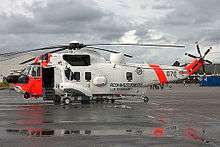
Anti-aircraft
- NASAMS Norwegian Advanced Surface to Air Missile System (based on the AIM-120 AMRAAM) 6 Units
- Robotsystem 70 and other systems.
Historical inventory

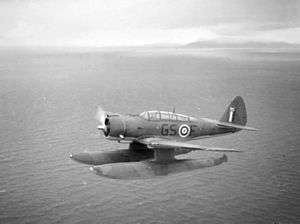
| Typ | Quantity | years of use | Notes |
| Agusta-Bell 47J/J-2 Bell 47D-1 Bell 47G-3 | 5 6 3 | 1958–1967 1953–1971 1954–1970 | |
| Airspeed Oxford I/II | 22 | 1947–1953 | |
| Avro Anson I | 10 | 1947–1951 | |
| Bell UH-1B | 37 | 1963–1990 | |
| Cessna L-19A (O-1A) | 27 | 1960–1992 | |
| Consolidated PBY | IV A: (3) IV B: 12 PBY-5A: 6 | 1945–1946 1945–1954 1954–1961 | |
| de Havilland Canada DHC-3 | 10 | 1953–1968 | |
| de Havilland Canada DHC-6 | 5 | 1967–2001 | |
| de Havilland Mosquito | T.III: 3 FB VI: 19 | 1947–1952 1945–1952 | |
| de Havilland Vampire | T.55: 6 F.III: 20 FB 52: 36 | 1952–1955 1948–1957 1949–1957 | |
| Douglas C-47A | 7 10 | 1945–1946 1950–1974 | |
| Douglas C-53D | 3 | 1945–1946 | |
| Fairchild M-62 | 74 | 1945–1957 | |
| Fairchild C-119G Flying Boxcar | 8 | 1956–1969 | |
| Fieseler Fi 156 Storch | 30 | 1945–1954 | |
| Grumman HU-16B (ASW) Albatross | 18 | 1961–1969 | |
| Junkers Ju 52/3m | 18 | 1945–1951 | |
| Lockheed C-56B/C-60A Lodestar | 7 | 1945–1950 | |
| Lockheed C-130E/H Hercules | 6 | 1969–2008 | |
| Lockheed F-104 (Canadair CF-104) | F-104G: 19 TF-104G: 4 CF-104: 19 CF-104D: 3 | 1963–1981 1963–1983 1973–1983 1973–1983 | |
| Lockheed T-33A | 22 | 1953–1968 | |
| Noorduyn Norseman IV/VI | 24 | 1945–1959 | |
| North American Harvard II/IIB/SNJ3/4 | 39 | 1945–1956 | |
| North American F-86 | F-86F: 115 F-86K: 64 | 1957–1967 1955–1967 | |
| Northrop N-3PB | 2 | 1945–1956 | |
| Northrop F-5 | A: 78 B: 14 RF-5A: 16 | 1966–2000 1966–2000 1969–2000 | |
| Piper L-18C | 16 | 1955–1992 | |
| Republic F-84 | F-84E: 6 F:84G: 200 RF-84F: 35 | 1951–1956 1952–1960 1956–1970 | |
| SAAB 91B/B-2 Safir | 30 | 1956–1988 | |
| Short Sunderland Mk V | (11) | 1945 | |
| Sikorsky H-19D-4 | 4 | 1958–1967 | |
| Supermarine Spitfire | LF.IXe: 73 PR XI: 3 | 1945–1952 1946–1954 | |
| Westland Lynx | Lynx Mk.86 | 1981–2014 | Was used by the Coast Guard, Replaced by NH90. |
| Focke-Wulf Fw 189A-2 | 1 | 1945–1946 | |
| Messerschmitt Bf 108 Taifun | 2 | 1945 | |
| Junkers W 34 | 1 | 1945–1946 |
Gallery
 The Royal Norwegian Navy Air Service' main aircraft in 1940 - the Marinens Flyvebaatfabrikk M.F.11.
The Royal Norwegian Navy Air Service' main aircraft in 1940 - the Marinens Flyvebaatfabrikk M.F.11._F.60_of_the_Royal_Norwegian_Navy_Air_Service.jpg) The M.F. 11's intended replacement - the Heinkel He 115N.
The M.F. 11's intended replacement - the Heinkel He 115N.
 Norwegian Army Air Service Fokker CV-D in 1990.
Norwegian Army Air Service Fokker CV-D in 1990. Gloster Gladiator in Norwegian colours on the ground in England 10 July 2005.
Gloster Gladiator in Norwegian colours on the ground in England 10 July 2005.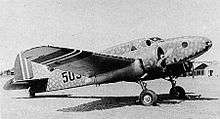 One of the four Norwegian Caproni Ca.310s c. 1939.
One of the four Norwegian Caproni Ca.310s c. 1939. Royal Norwegian Air Force F-5A Freedom Fighter aircraft flying in close formation with a New Jersey Air National Guard F-4 Phantom II aircraft during an exercise in 1982.
Royal Norwegian Air Force F-5A Freedom Fighter aircraft flying in close formation with a New Jersey Air National Guard F-4 Phantom II aircraft during an exercise in 1982.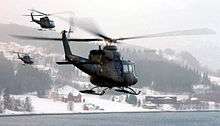 Norwegian Bell 412 SP.
Norwegian Bell 412 SP. F-16A #672 carrying four AIM-120 AMRAAMs and two AIM-9 Sidewinders. The Norwegian F-16s were the first to be equipped with drogue parachutes (located in the rectangular extension at the base of the tail fin).
F-16A #672 carrying four AIM-120 AMRAAMs and two AIM-9 Sidewinders. The Norwegian F-16s were the first to be equipped with drogue parachutes (located in the rectangular extension at the base of the tail fin).
.jpg) Norwegian Lockheed P-3 Orion at the East Fortune airshow in 2015
Norwegian Lockheed P-3 Orion at the East Fortune airshow in 2015
See also
- Free Norwegian forces
- Heavy Airlift Wing
- List of air forces
- List of Lockheed F-104 Starfighter operators
- List of military aircraft of Norway
- Strategic Airlift Capability
Footnotes
- ↑ Norsk rikskringkasting: Generalmajor Per Egil Rygg (Norwegian)
- ↑ Official Norwegian Defence Force website: History of the Royal Norwegian Air Force (Norwegian)
- ↑ Finnish Air Force Aircraft of WWII
- ↑ The Norwegian Air Force chief's address to Oslo Military Society in 2004
- ↑ NATO bombing of Yugoslavia
- ↑ John Pike. "OEF – Operation Desert Lion". Retrieved 24 December 2014.
- ↑ Dutch MoD on the 1 NLD/NOR EEAW
- ↑ "Norway condemns violence in Libya, Bahrain and Yemen". Ministry of Foreign Affairs. Retrieved 2011-02-22.
- ↑ Kristoffer Egeberg keg@dagbladet.no På Twitter: @InfoKeg (2011-03-20). "Vet ikke hvilke farer som møter dem – nyheter". Dagbladet.no. Retrieved 2013-11-27.
- ↑ "Her flyr norske jagerfly mot Libya – VG Nett om Libya". Vg.no. 1970-01-01. Retrieved 2013-11-27.
- ↑ kl.12:18 (2011-03-24). "To norske F16-fly har tatt av fra Souda Bay-basen – nyheter". Dagbladet.no. Retrieved 2013-11-27.
- ↑ Jonas Sverrisson Rasch jon@dagbladet.no PÅ KRETA (2011-03-26). "Norske fly bombet flybase i Libya i natt – nyheter". Dagbladet.no. Retrieved 2013-11-27.
- ↑ Martin Skjæraasen. "Norske fly i kamphandlinger i Libya – Aftenposten". Aftenposten.no. Retrieved 2013-11-27.
- ↑ Jonas Sverrisson Rasch jon@dagbladet.no (2011-04-15). "Norske fly har aldri bombet så mye – nyheter". Dagbladet.no. Retrieved 2013-11-27.
- 1 2 "Bekrefter norske bomber over Tripoli – VG Nett om Libya". Vg.no. 1970-01-01. Retrieved 2013-11-27.
- ↑ "Archived copy" (PDF). Archived from the original (PDF) on April 5, 2012. Retrieved April 5, 2012.
- ↑ ESPEN RØST ero@dagbladet.no (2011-04-26). "Norske F16-fly angrep Kadhafis hovedkvarter – nyheter". Dagbladet.no. Retrieved 2013-11-27.
- ↑ "Hardball with Chris Matthews". MSNBC. 2012-06-04. Retrieved 2013-11-27.
- ↑ Toralf Sandø , Ingeborg Eliassen. "Amerikanske medier: Norske F16-fly angrep Gadafis hovedkvarter – Aftenposten". Aftenposten.no. Retrieved 2013-11-27.
- ↑ "Norsk bidrag til Operation Ocean Shield". Retrieved 24 December 2014.
- ↑ Norwegian Orion found pirates
- ↑ Will Worley. "F16 fighter jet saves patient's life by flying medical equipment across Norway". The Independent. Retrieved 23 April 2016.
- ↑ "Accidental shot by F-16 caused great danger on Norwegian artillery range". Norwaytoday.info. 24 April 2016. Retrieved 24 April 2016.
- ↑ "The Joint Strike Fighter recommended to replace the F-16". Norwegian Prime Minister's Office. 20 November 2008. Retrieved 21 November 2008.
- ↑ Forsvarsdepartementet. "Et Forsvar for vår tid". 2012 White Paper. Regjeringen. Retrieved 22 April 2012.
- ↑ "Norway reduces airbase close to capital Oslo". AIRheads↑FLY. Retrieved 24 December 2014.
- ↑ Archived July 22, 2012, at the Wayback Machine.
- ↑ "Front page". Mil.no. Retrieved 2013-11-27.
- ↑ "Front page". Mil.no. Retrieved 2013-11-27.
- ↑ "Front page". Mil.no. Retrieved 2013-11-27.
- 1 2 3 4 "World Air Forces 2016". Flightglobal. Flightglobal International. December 2015.
- ↑ "Norway Welcomes First F-35, Signals More Purchases Likely". dodbuzz.com. Retrieved 19 March 2016.
- 1 2 3 4 5 6 7 "World Air Forces 2015 pg. 24". Flightglobal Insight. 2015. Retrieved 10 October 2015.
External links
- Norwegian Defence 2005 – Facts from the Ministry of Defence
- RNoAF Equipment Facts (English)
- History of the Royal Norwegian Air Force (Norwegian)
- Norwegian Aviation Museum
- ML407 – The Norwegian Story
- Norwegian Air Force – Air Show in Kristiansand
- www.mil.no English pages
| Wikimedia Commons has media related to Luftforsvaret. |



